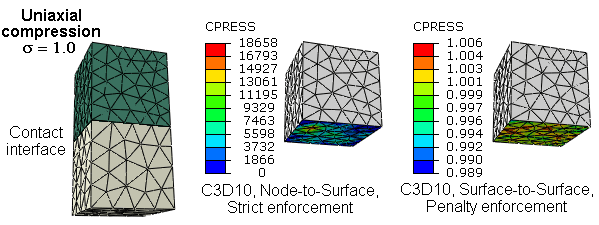
Product: Abaqus/Standard
Benefits: Disallowing the combination of second-order triangular slave faces, a node-to-surface contact formulation, and strictly enforced hard contact conditions avoids situations in which unintentional use of this combination leads to poor convergence behavior and/or noisy contact pressure predictions.
Description: The combination of second-order triangular slave faces, a (finite- or small-sliding) node-to-surface contact formulation, and strictly enforced hard contact conditions has fundamental numerical issues that tend to degrade convergence behavior and cause severe noise in contact pressure and contact shear stress (CPRESS and CSHEAR) predictions. This combination can be avoided in Abaqus/Standard by making one or more of the following changes:
Use the surface-to-surface contact formulation instead of the node-to-surface contact formulation;
Use the penalty or augmented Lagrange constraint enforcement method instead of strict enforcement of “hard” contact conditions; or
Use modified second-order tetrahedral elements (C3D10M) instead of regular second-order tetrahedral elements.
The surface-to-surface contact formulation and penalty method are generally recommended modeling practices; but, for historical reasons, the node-to-surface formulation and strictly enforced hard contact are assumed defaults in the *CONTACT PAIR keyword interface for finite-sliding interactions. Therefore, this undesirable combination may be present unintentionally in your models. (In Abaqus/CAE, the default contact interaction settings use the surface-to-surface formulation.)
An example of the very large contact pressure noise that typically occurs with the modeling combination being disallowed is shown in Figure 11–3. The combination of C3D10 elements, a node-to-surface contact discretization approach, and strict enforcement of “hard” contact conditions overestimates the maximum contact pressure by many orders of magnitude in this example. Figure 11–3 shows that a preferred modeling approach deviates from the analytical solution by approximately 1%. Table 11–2 compares the amount of numerical error in the contact pressure solution for various modeling combinations (the two combinations shown in Figure 11–3 are the first and last cases in this table).
Figure 11–3 Simple example of two contacting blocks under uniform pressure loading showing very large contact pressure noise with the combination of modeling techniques that is being disallowed and a low contact pressure noise with a preferred modeling approach.

Table 11–2 Deviation from analytical (uniform) contact pressure solution for example with two blocks under uniaxial loading.
| Contact discretization | Element type | Constraint enforcement method | Maximum error in CPRESS |
|---|---|---|---|
| Node-to-surface | C3D10 | Direct | 4 orders of magnitude |
| Node-to-surface | C3D10M | Direct | 35.4% |
| Node-to-surface | C3D10 | Penalty (default stiffness) | 21.2% |
| Surface-to-surface | C3D10 | Direct | 1.9% |
| Surface-to-surface | C3D10 | Penalty (default stiffness) | 1.1% |